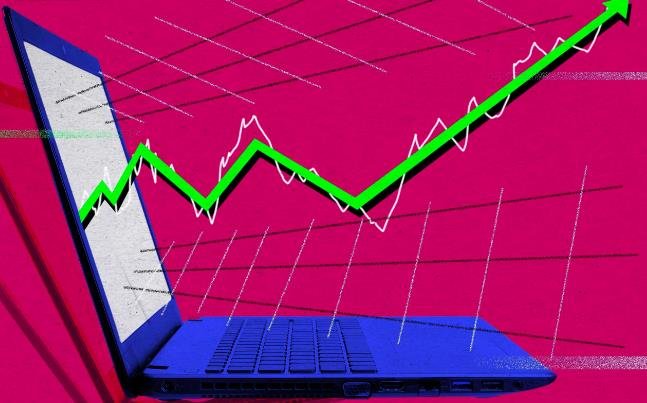The stock market has enjoyed a strong performance in the first half of 2023, driven by robust gains in tech stocks such as Microsoft, Oracle, and Palantir. However, some caution signs are emerging that could challenge the bullish outlook for the next six months.
Tech Stocks Lead the Market Higher
The tech sector has been the main engine of growth for the stock market in 2023, as cloud computing, generative AI, and data analytics have boosted the earnings and revenues of many tech companies. Microsoft, for instance, reported a 25% increase in its fiscal fourth-quarter profit, beating analysts’ expectations and sending its shares to a new all-time high. Oracle, which has been undergoing a turnaround in its cloud business, also delivered a strong earnings report that lifted its stock to a record level. Palantir, a data-mining company that went public in 2021, saw its shares soar more than 80% in the past three months, as it won several lucrative contracts from government agencies and private clients.
The tech rally has helped the Nasdaq composite index gain 4% in July, following a 6% rise in June. The S&P 500 index, which has a large exposure to tech stocks, also advanced 3.1% in July, after a 4.5% increase in June. The Dow Jones Industrial Average, which consists of blue-chip names from various sectors, rose 3.4% in July, adding to a 5.2% gain in June.

Fed Hikes Rates to Curb Inflation
However, the strong economic recovery that has fueled the stock market’s ascent has also brought some challenges, such as rising inflation and labor shortages. The Federal Reserve, which has been maintaining an accommodative monetary policy since the onset of the pandemic, decided to raise its benchmark interest rate by a quarter point on July 26, bringing it to a range of 5.25%-5.5%. This was the fourth rate hike this year, as the Fed aims to keep inflation under control and prevent the economy from overheating.
The Fed’s rate hike was widely expected by the market, but it also signaled that the central bank is not done tightening its policy yet. According to Fed fund futures, the market is pricing in a 68% chance of another quarter-point hike at the next Fed meeting in September, which would bring the policy rate to 3%-3.25%. The odds that the policy rate will hit a range of 3.5%-3.75% by the end of the year are 47%.
The rising interest rates could pose a headwind for the stock market, as they increase the borrowing costs for businesses and consumers, and reduce the attractiveness of equities relative to fixed-income assets. Moreover, higher interest rates could weigh on the valuations of tech stocks, which tend to have high growth expectations and high price-to-earnings ratios.
Other Risks Loom Over the Horizon
Besides the Fed’s policy moves, there are other risks that could dampen the stock market’s mood in the next six months. One of them is the ongoing Covid-19 pandemic, which has seen a resurgence of cases and deaths due to the highly contagious Delta variant. The US reported more than 100,000 new infections on July 30, the highest daily tally since February. The surge in cases has raised concerns about the possibility of new lockdowns or restrictions that could hamper the economic reopening and recovery.
Another risk is the geopolitical tension between Ukraine and Russia, which has escalated in recent weeks. Russia has amassed more than 100,000 troops near its border with Ukraine, sparking fears of a military invasion or conflict. The US and its allies have expressed their support for Ukraine’s sovereignty and territorial integrity, and warned Russia of serious consequences if it provokes a war. The situation in Ukraine could have a negative impact on the global markets, as it could disrupt trade flows, energy supplies, and diplomatic relations.
Conclusion
The stock market has had a remarkable run in the first half of 2023, thanks to the impressive performance of tech stocks and the economic recovery from the pandemic. However, investors should be aware of some caution signs that could challenge the bullish outlook for the next six months. These include rising interest rates from the Fed’s tightening policy, rising Covid-19 cases from the Delta variant, and rising geopolitical tension between Ukraine and Russia. These factors could create uncertainty and volatility for the market in the second half of 2023.
